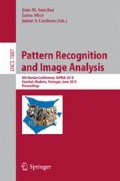Abstract
The EEG acquired simultaneously with functional magnetic resonance imaging (fMRI) is distorted by a number of artefacts related to the presence of strong magnetic fields. In order to allow for a useful interpretation of the EEG data, it is necessary to reduce these artefacts. For the two most prominent artefacts, associated with magnetic field gradient switching and the heart beat, reduction methods have been developed and applied successfully. Due to their repetitive nature, such artefacts can be reduced by subtraction of the respective template retrieved by averaging across cycles. In this paper, we investigate additional artefacts related to the MR environment and propose a method for the reduction of the vibration artefact caused by the cryo-cooler compression pumps system. Data were collected from the EEG cap placed on an MR head phantom, in order to characterise the MR environment related artefacts. Since the vibration artefact was found to be repetitive, a template subtraction method was developed for its reduction, and this was then adjusted to meet the specific requirements of patient data. The developed methodology successfully reduced the vibration artefact by about 90% in five EEG-fMRI datasets collected from two epilepsy patients.
Access this chapter
Tax calculation will be finalised at checkout
Purchases are for personal use only
Preview
Unable to display preview. Download preview PDF.
References
Allen, P.J., Josephs, O., Turner, R.: A method for removing imaging artifact from continuous eeg recorded during functional mri. NeuroImage 12(2), 230–239 (2000)
Allen, P.J., Polizzi, G., Krakow, K., Fish, D.R., Lemieux, L.: Identification of eeg events in the mr scanner: The problem of pulse artifact and a method for its subtraction. NeuroImage 8(3), 229–239 (1998)
Debener, S., Mullinger, K.J., Niazy, R.K., Bowtell, R.W.: Properties of the ballistocardiogram artefact as revealed by eeg recordings at 1.5, 3 and 7 t static magnetic field strength. International Journal of Psychophysiology 67(3), 189–199 (2008)
Debener, S., Strobel, A., Sorger, B., Peters, J., Kranczioch, C., Engel, A.K., Goebel, R.: Improved quality of auditory event-related potentials recorded simultaneously with 3-t fmri: Removal of the ballistocardiogram artefact. NeuroImage 34(2), 587–597 (2007)
Carmichael, D.W., Kleinschmidt, A., Laufs, H., Daunizeau, J.: Recent advances in recording electrophysiological data simultaneously with magnetic resonance imaging. NeuroImage 40, 515–528 (2008)
Jefferys, J.G.R., de la Prida, L.M., Wendling, F., Bragin, A., Avoli, M., Timofeev, I., Lopes da Silva, F.H.: Mechanisms of physiological and epileptic hfo generation. Progress in Neurobiology 98(3), 250–264 (2012)
Laufs, H.: Endogenous brain oscillations and related networks detected by surface eeg-combined fmri. Human Brain Mapping 29(7), 762–769 (2008)
Mullinger, K., Brookes, M., Stevenson, C., Morgan, P., Bowtell, R.: Exploring the feasibility of simultaneous electroencephalography/functional magnetic resonance imaging at 7 t. Magnetic Resonance Imaging 26(7), 968–977 (2008)
Niazy, R.K., Beckmann, C.F., Iannetti, G.D., Brady, J.M., Smith, S.M.: Removal of fmri environment artifacts from eeg data using optimal basis sets. NeuroImage 28(3), 720–737 (2005)
Ritter, P., Villringer, A.: Simultaneous eeg-fmri. Neuroscience; Biobehavioral Reviews 30(6), 823–838 (2006)
Salek-Haddadi, A., Friston, K.J., Lemieux, L., Fish, D.R.: Studying spontaneous eeg activity with fmri. Brain Research Reviews 43(1), 110–133 (2003)
Author information
Authors and Affiliations
Editor information
Editors and Affiliations
Rights and permissions
Copyright information
© 2013 Springer-Verlag Berlin Heidelberg
About this paper
Cite this paper
Rothlübbers, S., Relvas, V., Leal, A., Figueiredo, P. (2013). Characterization and Reduction of MR-Environment-Related EEG Artefacts. In: Sanches, J.M., Micó, L., Cardoso, J.S. (eds) Pattern Recognition and Image Analysis. IbPRIA 2013. Lecture Notes in Computer Science, vol 7887. Springer, Berlin, Heidelberg. https://doi.org/10.1007/978-3-642-38628-2_96
Download citation
DOI: https://doi.org/10.1007/978-3-642-38628-2_96
Publisher Name: Springer, Berlin, Heidelberg
Print ISBN: 978-3-642-38627-5
Online ISBN: 978-3-642-38628-2
eBook Packages: Computer ScienceComputer Science (R0)

